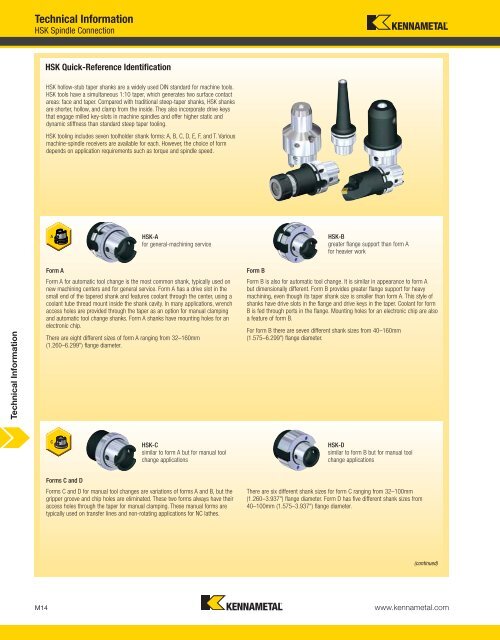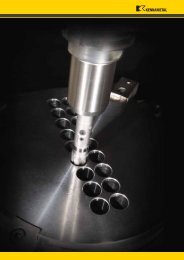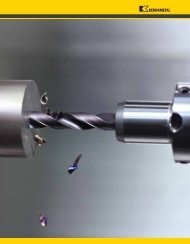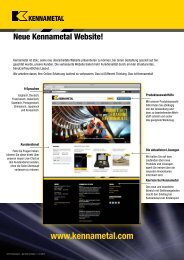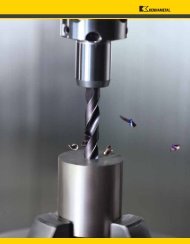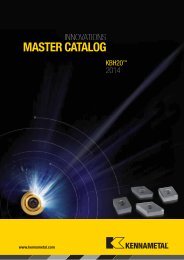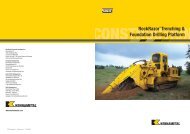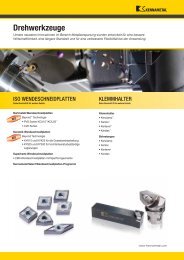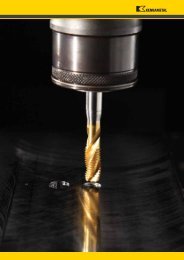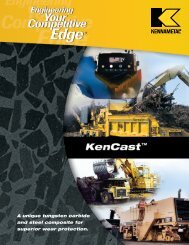Create successful ePaper yourself
Turn your PDF publications into a flip-book with our unique Google optimized e-Paper software.
<strong>Technical</strong> <strong>Information</strong><br />
<strong>Technical</strong> <strong>Information</strong><br />
HSK Spindle Connection<br />
HSK Quick-Reference Identification<br />
HSK hollow-stub taper shanks are a widely used DIN standard for machine tools.<br />
HSK tools have a simultaneous 1:10 taper, which generates two surface contact<br />
areas: face and taper. Compared with traditional steep-taper shanks, HSK shanks<br />
are shorter, hollow, and clamp from the inside. They also incorporate drive keys<br />
that engage milled key-slots in machine spindles and offer higher static and<br />
dynamic stiffness than standard steep taper tooling.<br />
HSK tooling includes seven toolholder shank forms: A, B, C, D, E, F, and T. Various<br />
machine-spindle receivers are available for each. However, the choice of form<br />
depends on application requirements such as torque and spindle speed.<br />
HSK-A<br />
for general-machining service<br />
Form A<br />
Form A for automatic tool change is the most common shank, typically used on<br />
new machining centers and for general service. Form A has a drive slot in the<br />
small end of the tapered shank and features coolant through the center, using a<br />
coolant tube thread mount inside the shank cavity. In many applications, wrench<br />
access holes are provided through the taper as an option for manual clamping<br />
and automatic tool change shanks. Form A shanks have mounting holes for an<br />
electronic chip.<br />
There are eight different sizes of form A ranging from 32–160mm<br />
(1.260–6.299") flange diameter.<br />
HSK-C<br />
similar to form A but for manual tool<br />
change applications<br />
Forms C and D<br />
Forms C and D for manual tool changes are variations of forms A and B, but the<br />
gripper groove and chip holes are eliminated. These two forms always have their<br />
access holes through the taper for manual clamping. These manual forms are<br />
typically used on transfer lines and non-rotating applications for NC lathes.<br />
HSK-B<br />
greater flange support than form A<br />
for heavier work<br />
Form B<br />
Form B is also for automatic tool change. It is similar in appearance to form A<br />
but dimensionally different. Form B provides greater flange support for heavy<br />
machining, even though its taper shank size is smaller than form A. This style of<br />
shanks have drive slots in the flange and drive keys in the taper. Coolant for form<br />
B is fed through ports in the flange. Mounting holes for an electronic chip are also<br />
a feature of form B.<br />
For form B there are seven different shank sizes from 40–160mm<br />
(1.575–6.299") flange diameter.<br />
HSK-D<br />
similar to form B but for manual tool<br />
change applications<br />
There are six different shank sizes for form C ranging from 32–100mm<br />
(1.260–3.937") flange diameter. Form D has five different shank sizes from<br />
40–100mm (1.575–3.937") flange diameter.<br />
(continued)<br />
M14 www.kennametal.com


